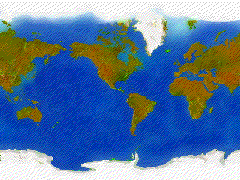“There is a grandeur in this view of life.”
Darwin & Mendel: the two sides of a biological “coin” – behavior & inheritance.
1,
Darwin and Mendel's legacy–“lessons about limits in another person's
eyes” F
2, The Entangled Bank– more lessons of natural laws from all around us M
3, Our Distant Past– “rocks of ages”
unseen remnants of a forgone world
F
outline | Limits | Evolution | Terms | Main Points | SUMMARY
outline
Introduction
Unknown to one another Darwin and Mendel discovered that variability and selection work
in tandem to produce viable offspring—members
of a potentially breeding population.
A biological “coin” ? –
one side is behavior–ethos &
the other side is inheritance–genetics.
Body
Eight significant points are the heart of the chapter, foreshadowing the book: within limits, “descent with modification” from a common ancestor leads to diversity over time, random mixture generates genetic variability, immunity or resistance, and biotic potential.
Thus, this hereditary composition
of a population assures our effective
survival, if not breeding.
evidence
moths, birds, anoles, fruit
flies, human blood cells, eye color, and enzymes.
argument
Conditional (surroundings) change + genetic inheritance = descent with
deviations
“it is usually very hard to select for just one
characteristic.”
“a gene consists of a series of nucleotides with
different bases that determine the sequence...
proteins” [with alterations =
modifications = deviations]
meaning
proteins (enzymes & hormones) are life’s essential
constituents, arbiters, & threads.
Conclusion
We like all of nature’s species are the products of variation & selection. To know truly what limits we have & how this biological treasure we are endowed with functions, we must unravel a complex puzzle among: the earth, ethology (behavior), ecology (surroundings), & molecular biology (competing means of regulatory feedback).
Our task is to
better know the world in us!
limits
Why
do your eye colors differ only within a limited range?
Three laws of
thermodynamics
1 energy (and matter) can neither be created nor destroyed; energy (E) is constant (k)
2 no
transfer of energy is ever completely efficient and
heat, as a loss, accumulates
3 eventually
the universe will have insufficient energy for life
Said another way, by Garret Hardin
You
can’t win
You
are bound to lose
You
cannot get out of the game
Evolution,
descendants vary with respect to
the traits they inherit and thus what survives depends
on what was produced earlier
[1]
by variable parents and grandparents.
Nothing
really evolves, but descendants vary greatly from their ancestors
Some
of that variable inheritance is passed on
Not
all traits are passed on, but natural selection favors functional assets
So
in a population many traits survive
that can endow future offspring with variety
Variety
is insurance against the storm
There
are no guarantees of success
Life
has the capacity to adapt to conditions that are not too extreme
Over
time due to isolation and variation, populations give rise to new species:
Finches
on the Galapagos Islands
Turtles
rails
Eight significant points:
1. Populations change within
limits [milieu’s limits + genome’s limits]
2. Natural selection favors
some traits among very variable offspring’s genomes
3. Isolation (loss) and the
pace of change among organisms can be rapid or slow
4. Linking evolution to
genetics is the Modern synthesis and a foundation of biology
5. Artificial selection by
humans and other organisms can change other creatures (fruit flies, cows, cats
& dogs, sheep, GMOs]
6. Change in the hereditary
composition of populations over time is due to DNA and RNA’s variability and functionally replicable chemistry.
7. Genotype & phenotype act
in such a way as phenotype is
selected for as an expression of genotype
[eye color in humans].
8. Changes in
a population’s genome is the raw material of evolution or shifts–alterations–in populations
of organisms over time.
We are the
products of the world we see around us, limited by its conditions plus our inherited and acquired traits to wither or prosper; as we can become proper caretakers,
or unreasonable exploiters of an unimaginably expensive endowment, which I will
call life’s diversity, beauty, and integrity on an imperiled planet.
The Dominant Animal on the web
